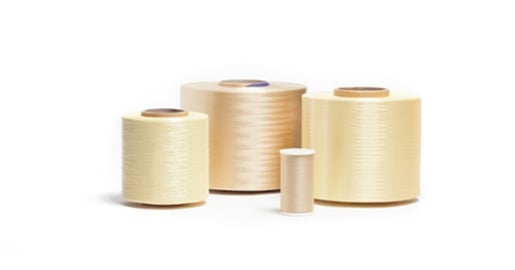 Both Vectran™ and Aramid yarns are known for being resilient materials used for specialized products. They each have varying degrees of creep resistance, abrasion resistance, high tensile strength, excellent flex/fold characteristics, long term dimensional stability and exceptional property retention at high temperatures. These yarns are extremely durable and often used to protect people and products.
Both Vectran™ and Aramid yarns are known for being resilient materials used for specialized products. They each have varying degrees of creep resistance, abrasion resistance, high tensile strength, excellent flex/fold characteristics, long term dimensional stability and exceptional property retention at high temperatures. These yarns are extremely durable and often used to protect people and products.
Due to the nature of these materials they are often used for aerospace and military purposes, and have everyday applications in things like sports equipment, hose reinforcement, electrical wire and cable binding and shielding.
Aramid
Aramid is characterized by its strength and heat resistance. Aramids are synthetic fibers divided up into two classes, meta-aramids and para-aramids. To get more information on the chemical make-up of aramid fibers visit our blog Common Industrial Kevlar® and Aramid Yarn Applications.
Meta-Aramid
A meta-aramid is a material manufactured by being spun in a chemical solution with a process known as wet spinning. In this manufacturing method, a polymer is drawn through a spinneret into a non-solvent. Other fibers that are spun using this method are rayon and spandex. The outcome of this procedure helps cause the fibers to withstand tensile stress during exposure to flames and temperatures up to 400 deg. C.
Once it has become highly resistant to high temperatures, chemical degradation and abrasion, it can be used in things like:
- Electrical insulation
- Protective clothing
- Automotive heat shields
- Aerospace applications
The most commonly known meta-aramid is Nomex®, however there are other manufacturers that are making competitive products.
Para-Aramid
This material is manufactured in a similar fashion as meta-aramid. Made using a method called dry jet spinning, this method is a modification of wet spinning where the spinneret is kept just outside the surface of the solution. This is what creates the change in structure for these two yarns. During this process fibers in the material are strengthened.
This strong material type can be used in:
- Bullet proof vests / other protective clothing
- Race cars
- Wire, cable and hose reinforcement
The most commonly known para-aramid yarn is Kevlar®, however this is just a brand name and there are many great alternatives to Kevlar®.
To learn more about the difference between meta-aramid and para-aramid yarns, click here.
Vectran™
Vectran™ is a high-performance multifilament yarn spun from a liquid crystal polymer, and is the only commercially available product of its kind. Vectran™ is known for its exceptional strength (Vectran™ fiber is five times stronger than steel and ten times stronger than aluminum), minimal moisture absorption, high cut and abrasion resistance and a high property retention over a wide temperature range. Vectran™ has a melt temperature of 625 degrees Fahrenheit.
Due to its unique nature, Vectran™ is often used in strenuous environments, such as deep sea or space explorations. NASA uses this material to create airbags for their rovers and small spacecrafts due to its light but tough nature, and according to their website Vectran™ performed better than Kevlar® did in the exceedingly cold temperatures.
Furthermore, its unique combinations of qualities also make it perfect for electronic products as well. Vectran™ is used in printed circuit boards, fiber optic strength members, and conductor reinforcements. Qualities like high dielectric strength, elevated temperature and moisture resistance helps it deliver electrical efficiency and prevents current leakage.
When compared to aramid, Vectran™ is:
- More creep resistant
- More chemical resistant
- More abrasion resistant, in both wet and dry conditions
- More impact resistant
- Better at vibration damping
- Less UV degradation resistant
In the case of protective clothing, Vectran™ also has superior bleach resistance than aramid fibers. This, along with its dimensional and chemical stability, makes garment care easier. Vectran™ apparel will retain its strength after multiple washes and will save the user money in the long run.
Do you need help determining if Vectran™ or aramid is the right yarn for your industrial applications? Service Thread’s experienced material specialists can help create the best solution for your unique product.
Other relevant blogs:



